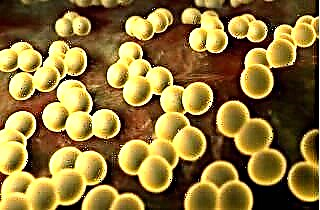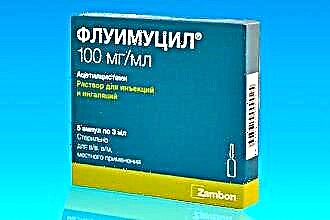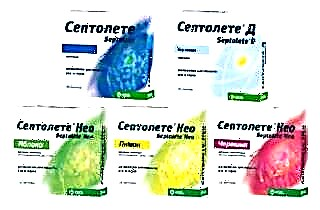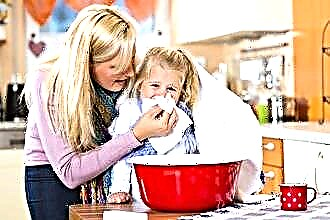Staphylococcus aureus is one of the most common bacteria found on human skin or mucous membranes. But for some reason, when it is found in children, parents start to panic. You should not worry too much, but it is also undesirable to ignore the first symptoms. The sooner staphylococcus aureus is found in a child's nose, the less likely it is that serious complications will develop.
Infection routes
Children can become infected with staphylococcus already at birth, passing through the birth canal of the mother. Often, the bacterium penetrates the umbilical wound when it  improper processing. Infected mucus can also end up in a child's nose and then spread further through the body.
improper processing. Infected mucus can also end up in a child's nose and then spread further through the body.
Premature babies are at the greatest risk, since they do not have developed immunity. No less dangerous is infection for babies who are bottle-fed from the very first days - their own immunity is still not strong enough, and he does not receive ready-made antibodies present in mother's milk. Therefore, if there is an opportunity to provide the baby with breast milk at least in minimal quantities, you cannot refuse it.
Staphylococcus often nests in clinics, hospitals and child care facilities. It is easy to find it on the hands of almost half of the medical workers, nannies, educators, kitchen workers. And since the bacterium is very tenacious, it is easily transferred to the skin and mucous membranes of the child, gets on food, remains on dishes, towels, bed linen.
Thus, by the age of 2, about half of the children are carriers of various types of this bacterium.
Manifestation of symptoms
Getting on the mucous membrane of the child's nose, staphylococcus begins to actively multiply and very quickly reaches the throat, penetrates the respiratory system and the digestive tract. In the course of its life, the bacterium releases toxins that destroy mucous cells and poison the baby.  A child's body is much more sensitive to toxic substances than an adult, so the first symptoms in children usually manifest themselves in a different way:
A child's body is much more sensitive to toxic substances than an adult, so the first symptoms in children usually manifest themselves in a different way:
- a sharp increase in temperature, which after a while decreases to subfebrile;
- the appearance of signs of severe intoxication: nausea, vomiting, upset stools;
- weakness, complete lack of appetite, drowsiness, frequent crying;
- severe flatulence and diarrhea are possible.
And those symptoms that first appear in an adult develop later in a child, and their localization is not so clearly expressed.
A red and / or purulent rash appears throughout the body or in certain areas. The mucous membranes of the nose become very inflamed and swollen, a profuse runny nose, sometimes purulent, begins. Purulent ulcers, boils, pimples can form in and around the nose.
Features of different types of staphylococcus
Staphylococci are very diverse. There are 27 species in total. Only four are dangerous to health, one of which does not settle in the nose, but affects the genitourinary system. The other three staphylococci on the nasal mucosa feel great and manifest themselves in different ways:
- Epidermal - quickly spreads over the surface of the skin, causing the formation of pimples, ulcers, acne on it. If untreated, dermatitis, eczema, folliculitis develops. If the bacterium enters the mucous membrane of the eye, it causes purulent conjunctivitis.
 Hemolytic - it is difficult to detect it immediately, as its symptoms are very similar to SARS. A severe runny nose begins, redness and swelling of the nasal mucosa appears, if it enters the throat, it causes pain and a severe cough. It is very important not to treat your baby with antibiotics on your own, as this can only aggravate the situation.
Hemolytic - it is difficult to detect it immediately, as its symptoms are very similar to SARS. A severe runny nose begins, redness and swelling of the nasal mucosa appears, if it enters the throat, it causes pain and a severe cough. It is very important not to treat your baby with antibiotics on your own, as this can only aggravate the situation.- Golden is the most common and dangerous type of staphylococcus that can affect internal organs and cause severe chronic diseases. It is he who most often nests in the child's nose and is very difficult to treat. It is quite easy to detect, since already in the first hours after infection, fluid-filled pimples appear in and around the nose, which then form purulent sores or boils.
It is possible to determine exactly what type of staphylococcus is present in the child's body by conducting a diagnostic examination.
Diagnostic methods
In the smallest, in order to sow staphylococcus, it is enough to take a feces analysis. This bacterium quickly penetrates the intestines and actively develops there. Another way to detect it is by bacteria seeding of mucus from the nose. This analysis allows not only to determine the strain of the pathogenic microorganism, but also to check its sensitivity to various drugs.
If the doctor suspects that the infection has already caused various complications, then he may suggest taking an x-ray of the nose or an ultrasound of the internal organs. In some cases, urine and blood tests may additionally be prescribed.
Only based on the results of laboratory tests, the pediatrician decides which drugs to treat staphylococcus aureus in this case.
Treatment regimen
There is no general treatment regimen for young children. In the absence of medical contraindications, cephalosporin antibiotics are usually prescribed.  series: "Ceftriaxone", "Cefotaxime", etc. We remind you that the final choice of the drug and the calculation of its dosage should be made by the doctor, and the parents should strictly follow his recommendations!
series: "Ceftriaxone", "Cefotaxime", etc. We remind you that the final choice of the drug and the calculation of its dosage should be made by the doctor, and the parents should strictly follow his recommendations!
In addition, funds are needed to strengthen the immune system: "Immunal", "IRS-19", etc. At the same time, it is desirable to give the child multivitamin preparations that accelerate metabolic processes and strengthen the baby's body. In case of severe intestinal disorders, Linex, Bifidumbacterin, Enterosgel will help to correct the situation.... As a last resort, you can give your child activated charcoal.
Chamomile, linden or raspberry tea (without sugar or honey!), Chamomile decoctions, rose water perfectly helps to relieve inflammation of the throat and intestines and quickly remove toxins. Foods containing a large amount of vitamin C are especially useful for the baby during this period: apricots, currants, blueberries. Children over 6 months old can be given puree of them (if there is no diarrhea).
Rinse the spout preferably with a sea salt solution or Aquamaris. An oily solution of chlorophyllipt, which needs to gargle and rinse the baby's nose, perfectly deals with staphylococcus.
Lubricate damaged areas of the skin and mucous membranes 2-3 times a day with brilliant green - perhaps the only antiseptic that can quickly destroy staphylococcus aureus.
Prevention measures
Considering that staphylococcus aureus is a conditionally pathogenic bacterium and is completely harmless for a healthy baby with strong immunity, the main preventive measures should be directed to the general health of the child. Naturally, when the baby is already sick, doing something is not only unnecessary, but also dangerous. But when the treatment is over and repeated tests, which need to be done a month after the end of the course, showed an acceptable amount of staphylococcus, you can start hardening.
 The main preventive measures are as follows:
The main preventive measures are as follows:
- teach the child to follow the basic rules of personal hygiene as early as possible;
- to provide him with full-fledged natural food rich in vitamins and microelements;
- strictly observe the sanitary standards for the storage and processing of food;
- monitor the cleanliness, temperature and humidity of the air in the baby's room;
- regularly perform wet cleaning of the room, clean carpets and upholstered furniture with a vacuum cleaner;
- remove from the child's room all substances that irritate the nasal mucosa and possible allergens (household chemicals, perfumes, flowers with a strong odor, etc.);
- if the child is healthy, walk with him daily in the fresh air, dressing him according to the weather;
- stimulate an active lifestyle: outdoor games, sports and gymnastics;
- regularly visit the clinic for preventive examinations.
If the baby is sick and the symptoms raise suspicion of staphylococcus aureus, in no case treat it yourself. This should only be done by a doctor!
It is equally important to strictly adhere to all appointments and to bring the treatment to the end. If bacteria remain in the body that have managed to adapt to the antibiotics used, then they will subsequently multiply, and it will no longer be possible to destroy them using the previously tried methods.
When a child falls ill in a family, adults will also have to undergo an examination, and possibly a course of treatment. Otherwise, they will constantly infect the baby again, and the baby will never get rid of the tenacious bacteria. Moreover, there is no guarantee that other family members did not become the source of the primary infection.

 Hemolytic - it is difficult to detect it immediately, as its symptoms are very similar to SARS. A severe runny nose begins, redness and swelling of the nasal mucosa appears, if it enters the throat, it causes pain and a severe cough. It is very important not to treat your baby with antibiotics on your own, as this can only aggravate the situation.
Hemolytic - it is difficult to detect it immediately, as its symptoms are very similar to SARS. A severe runny nose begins, redness and swelling of the nasal mucosa appears, if it enters the throat, it causes pain and a severe cough. It is very important not to treat your baby with antibiotics on your own, as this can only aggravate the situation.

